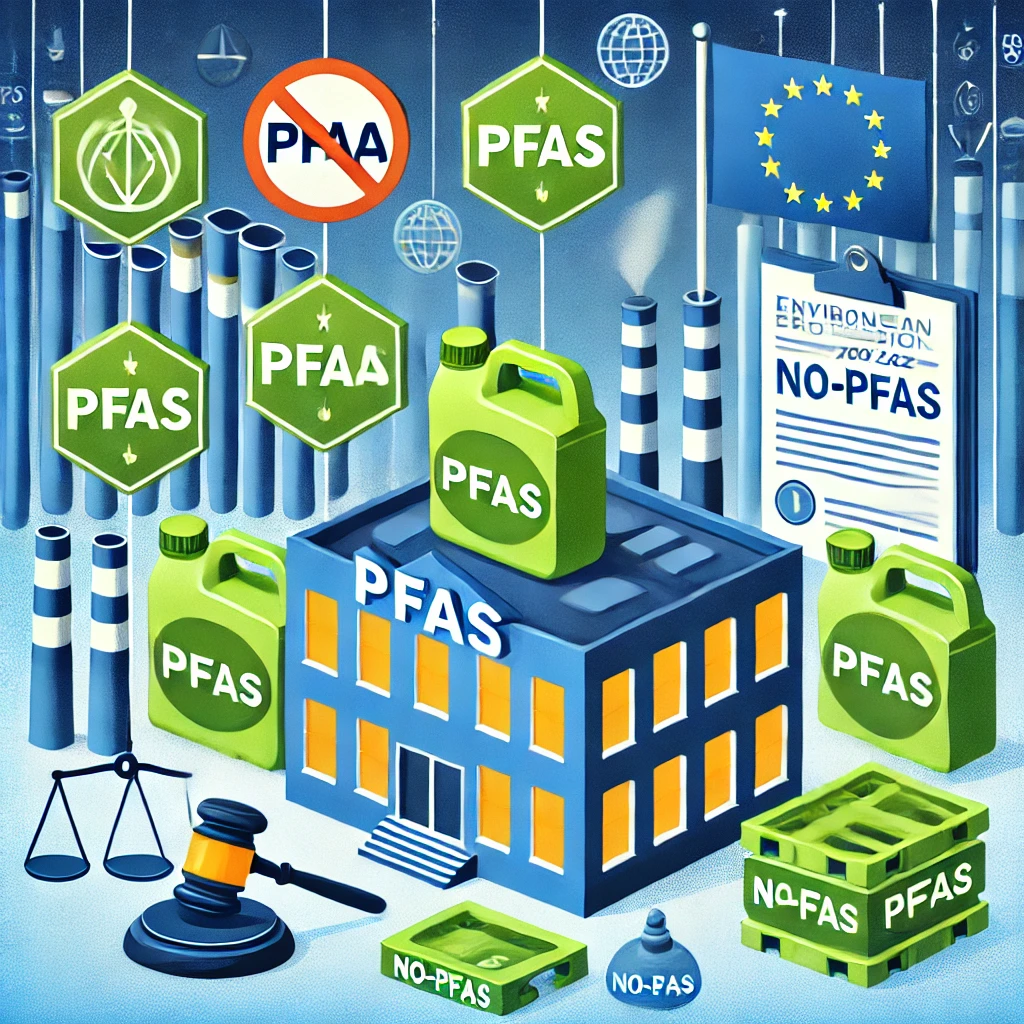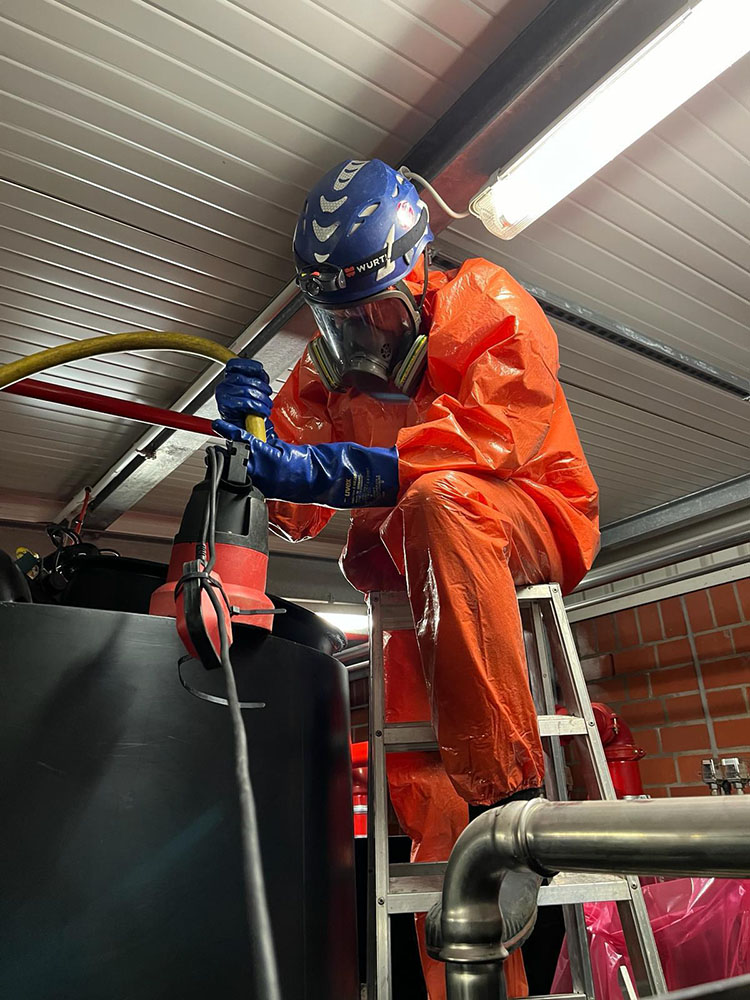PFAS Decontamination – Do I have to completely renew or even demolish my tank or silo system?During our operations involving the decontamination of tank or silo systems, we are often confronted with the same statement from plant operators: Instead of a professional decontamination, sprinkler companies recommend demolishing existing tank and silo systems after inspecting them.
Due to the high PFAS contamination, cleaning or decontamination is no longer possible, and a new design is recommended. This statement is not only false but also represents a massive investment for the plant operator in a new construction that is almost never necessary. A suitable specialist company is capable of performing decontamination according to the applicable regulations and laws, both technically and in the laboratory. However, an expert specialist company also has the obligation to inform the plant operator after a diligent assessment if decontamination is not technically possible or economically feasible.
A high PFAS contamination is life-threatening for humans and the environment, and in this context, diligence and safety always take priority over economic interests.
NT Service GmbH’s experts have been specializing in PFAS decontamination for over ten years. We have already successfully completed more than 200 projects in this context. Our team inspects your foam agent tank systems and advises you comprehensively. If decontamination is necessary and feasible, we look forward to your order.
What is PFAS, and in what context does the substance appear?
Perfluorinated alkyl substances (PFAS) have been produced in industry for many decades. The main reason was that these chemical compounds are suitable for making various materials water, heat, and fat repellent.
PFAS-containing substances were used in many industries for surface treatment of:
• Building materials
• Electronic parts
• Household items
• Cable sheaths
• Medical technology products
• Metallurgical products
• Paper finishing processes
• Chemical industry products
• Textiles
These dangerous compounds are often found in raw materials stored in tanks or silo systems at manufacturing companies or in industry.
Additionally, PFAS-containing ingredients are found in these often-used:
• Hydraulic fluids
• Firefighting foam
• Cleaning agents and thereby enter tanks and silo systems.
It is even more alarming when people come into contact with these substances during release or the environment is contaminated with PFAS-containing substances.
Why is it stated that PFAS-contaminated systems cannot be decontaminated?
EU ban regulations on the handling of harmful PFAS compounds serve as the legal basis. These compounds are particularly present in firefighting foams in tank and silo systems. Since there are no technical recommendations for cleaning and decontamination, many commissioned companies advise demolishing and rebuilding existing systems out of caution.
The error that simple cleaning companies make is assuming that PFAS has diffused into specific materials and therefore cannot be cleaned. This diffusion is technically possible, but a suitable decontamination process can easily remediate it without having to replace or demolish the entire system. In any case, recommending a system’s new construction due to PFAS contamination is completely wrong.
Upon closer examination, it was found that the problem is not the migration of individual molecules from the PFAS compound into the tank system. It is the inadequate form of cleaning the tank system, which was chosen as an excuse to justify the remaining PFAS molecules in the tank system. This expert opinion has been confirmed by numerous PFAS decontamination projects successfully completed by NT Service GmbH.
NT Service GmbH’s experts have been specialists in PFAS decontamination for over 10 years. We have successfully completed more than 200 projects in this area. Our team will inspect your foam concentrate tank systems and provide comprehensive advice. If decontamination is necessary and feasible, we look forward to your order.
What is PFAS and in what context does the substance occur?
Polyfluorinated alkyl compounds (PFAS) have been produced in industry for many decades. The main reason was that these chemical compounds are suitable for making various materials water, heat, and fat resistant.
PFAS-containing substances were used in many industries for surface treatment of:
• Building materials
• Electronic parts
• Household items
• Cable sheathing
• Medical technology products
• Metallurgical products
• Paper finishing processes
• Chemical industry products
• Textiles
Often, these dangerous compounds are found in raw materials stored in tanks or silo systems at manufacturing companies or in industry.
In addition, PFAS-containing ingredients are found in commonly used:
• Hydraulic fluids
• Firefighting foams
• Cleaning agents
and thus enter tanks and silos. It is even more concerning when people come into contact with the substances when they leak, or when the environment is contaminated with PFAS-containing substances.
Why is it said that PFAS-contaminated systems cannot be decontaminated?
EU ban regulations on the handling of health-hazardous PFAS compounds serve as the legal basis. These compounds are particularly present in firefighting foams used in tanks and silo systems. Since there is a lack of technical recommendations for cleaning and decontamination, many companies advise caution and recommend the demolition and rebuilding of existing facilities.
Read our article from February 23, 2022, on our website under the “Projects” section for more information:
https://tnt-reinigung.de/de/projekte/i-1391-aktuelles-verbot-fuer-gesundheitsschaedliche-pfc-feuerloeschschaeume-in-europa
The mistake that simple cleaning companies make is assuming that PFAS has diffused into certain materials and is therefore no longer cleanable. This diffusion is technically possible, but can be easily remedied through a suitable decontamination process, without having to replace or demolish the entire system. In any case, recommending the construction of a new system due to PFAS contamination is completely wrong.
Upon closer examination, it was found that it is not the migration of individual molecules from the PFAS compound in the tank system that is the problem. It is the inadequate cleaning of the tank system that was chosen as an excuse to justify the remaining PFAS molecules in the tank system.
What is PFAS, and why is it a concern?
Perfluorinated alkyl substances (PFAS) are chemical compounds used for their water, heat, and fat-repellent properties. They are found in building materials, electronics, household items, and firefighting foams. PFAS contamination poses severe health risks to humans and the environment, making effective decontamination crucial.
Why do some companies recommend demolishing PFAS-contaminated systems?
Some companies recommend demolishing PFAS-contaminated systems due to a lack of technical knowledge and the assumption that PFAS diffuses into materials and cannot be removed. However, with proper decontamination processes, PFAS can be effectively eliminated without the need for demolition or replacement of the entire system.
How can PFAS contamination in tank and silo systems be effectively managed?
Effective management of PFAS contamination in tank and silo systems involves thorough inspection and professional decontamination by specialized companies. These companies use advanced techniques to remove PFAS, ensuring the safety and functionality of the systems without the need for costly replacements.
What are the regulatory guidelines for handling PFAS contamination?
EU regulations ban the use of harmful PFAS compounds, particularly in firefighting foams. These regulations serve as a legal framework for managing PFAS contamination. Companies must follow these guidelines to ensure safe decontamination practices and protect both human health and the environment.
Why choose NT Service GmbH for PFAS decontamination?
NT Service GmbH has over a decade of experience in PFAS decontamination, successfully completing more than 200 projects. Their expertise ensures comprehensive inspection and effective decontamination of foam agent tank systems, providing reliable and cost-effective solutions for plant operators.



